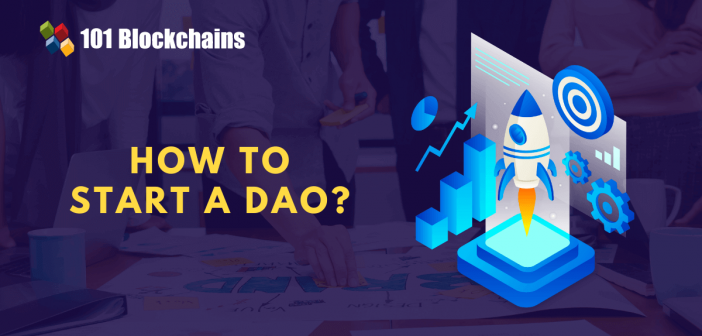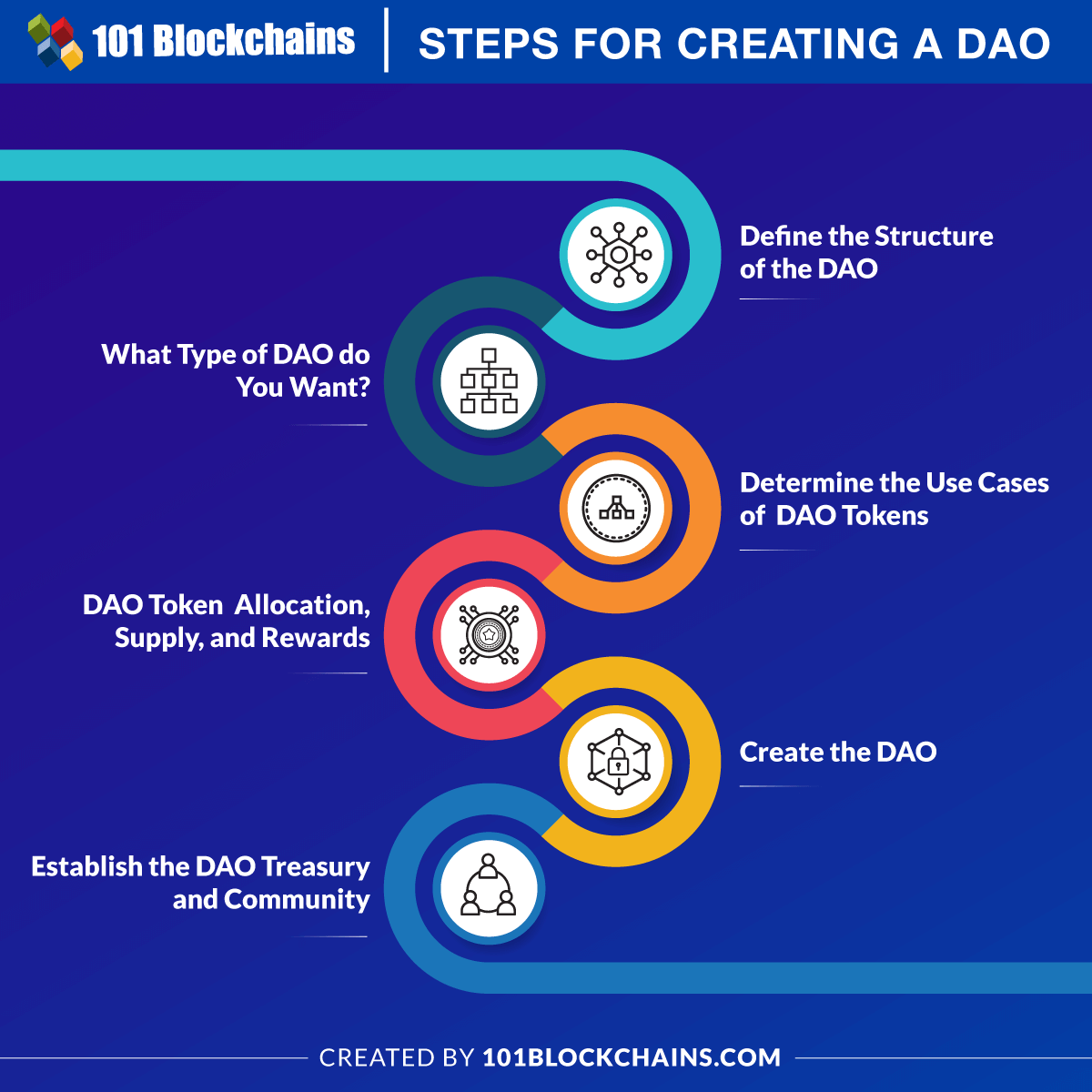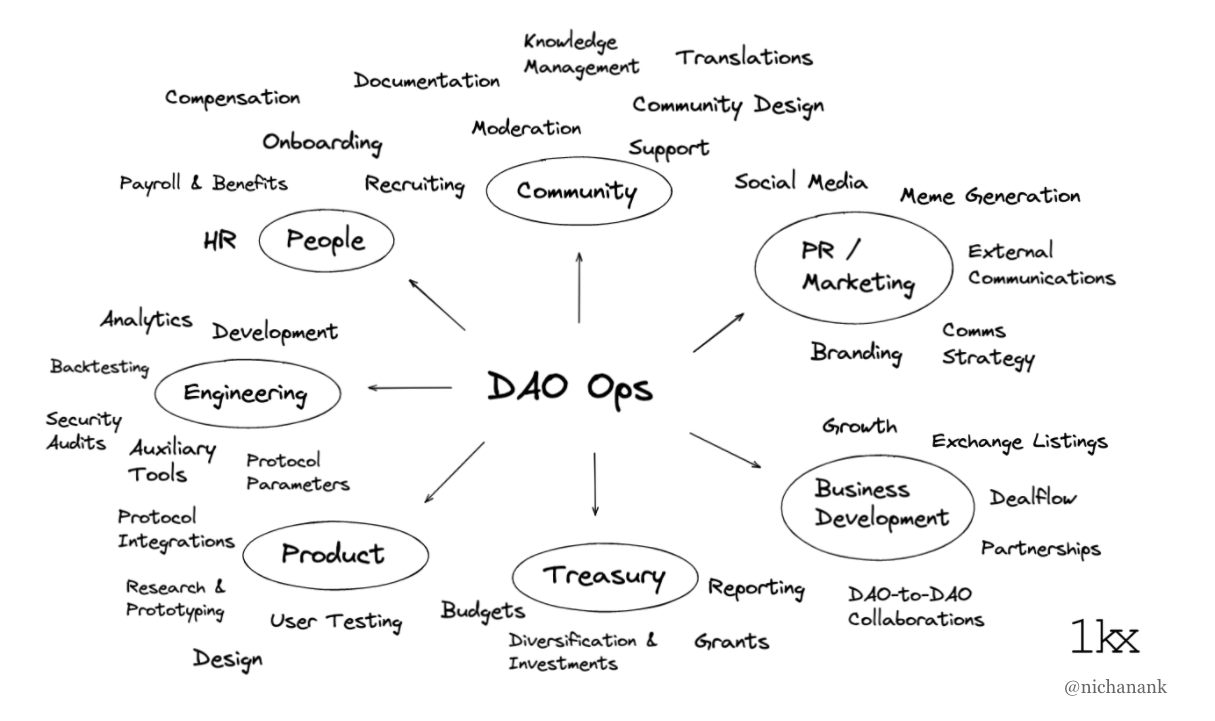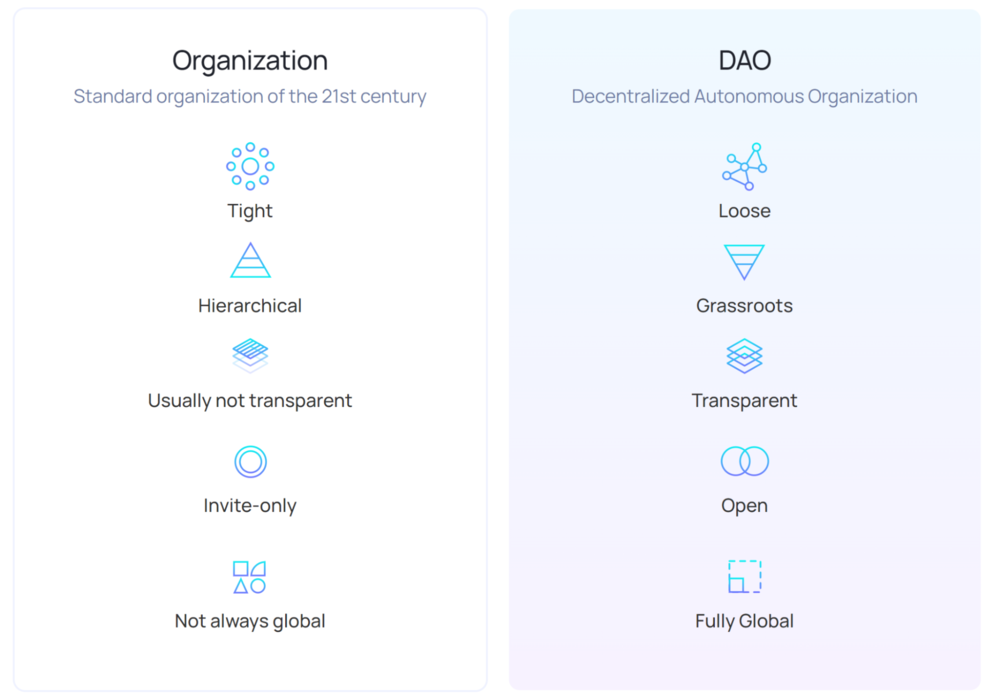Learn how blockchain truly works, master key definitions, and uncover what makes smart contracts so "smart." Dive into the fundamentals, gain valuable insights, and start your blockchain journey today!

- Guides
Georgia Weston
- on May 06, 2022
How to start a DAO?
The arrival of Decentralized Autonomous Organizations or DAOs has emerged as a promising intervention in the gradually evolving web3 landscape. DAOs are gradually growing in terms of popularity for launching web3 projects and businesses. As developers and enterprises start seeking more use cases of DAO, the interest in ‘how to start a DAO’ has been gaining momentum. Embodying the principles of true decentralization alongside offering an autonomous structure, DAOs are a revolutionary tool for facilitating governance in the new breed of decentralized applications.
A simple impression of answers to “How does a DAO work?” would suggest how it empowers the organization members with a definitive share in the decision-making process. However, the basics of DAOs and their working are not enough to start a DAO. How can you start a DAO? The following discussion helps you find the answer with distinct steps for creating your own Decentralized Autonomous Organizations DAOs.
Excited to develop fluent knowledge of the DAO ecosystem? Enroll Now in DAO Fundamentals Course
Steps for Creating a DAO
The foremost requirement for anyone interested in starting a DAO would focus on the basics of decentralized autonomous organizations. You must be familiar with the definition of DAO and how they work before creating one. In addition, you must take note of the benefits of DAOs and use cases of DAOs for determining the suitable value propositions of DAOs in different projects. Take note of the fact that you can build DAOs on multiple blockchain networks. However, Ethereum is the standard blockchain network for creating a DAO in the present time. With the basics of DAOs cleared up, you can dive into the following steps for creating your DAO.

1. Define the Structure of the DAO
Many people are often confused about “How do you start a decentralized autonomous organization?” as they don’t have any idea about the starting point. Before writing code or purchasing any DAO tools, you need to figure out the reason for building the DAO. In addition, you must also look for the structure you want for the DAO. Even if DAOs introduce the benefits of decentralization, it is not reasonable to implement them everywhere. The good performance of DAOs can encourage people to implement them in different organizations, projects, and communities. However, they are not the best option in all cases, as the 2017 ICO boom proved clearly.

Image Source: https://medium.com/1kxnetwork/organization-legos-the-state-of-dao-tooling-866b6879e93e
How can you define the structure of the DAO? You must take note of the following factors before you start creating the DAO.
- Objectives of creating the DAO alongside short-term and long-term vision for the same.
- The urgency for a decentralized ownership structure.
- Decision-making approaches in the DAO.
- Challenges are resolved by creating a DAO in your industry.
- Benefits of a DAO for the customers, users, and community.
- Previous instances of DAO implementation.
- Possibilities for community-centric aspects when you create a DAO alongside preparation for unprecedented consequences in the crypto market.
A clear overview of these factors helps you move ahead to the next step in the DAO creation process.
Learn the concepts of Decentralized Autonomous Organizations and their role in web3 with DAO Flashcards
2. What Type of DAO do You Want?
The second step in starting a DAO focuses on determining the type of DAO you need. Decentralized Autonomous Organizations, or DAOs, are still in the stages of infancy and can serve many use cases. Therefore, you can opt for many practical paths for creating your DAO according to your objectives. You must go through different types of DAOs and their functionalities to find the models which can fulfill your goals. Some of the most common types of DAOs include protocol DAOs, social DAOs, venture DAOs, collector DAOs, and social media DAOs.

Image Source: https://aragon.org/dao
At the same time, you must also focus on common goals between DAOs and traditional businesses for improved efficiency. For example, if you are wondering how to start a DAO, you can use a nation-state governance framework for mapping out the general DAO structure. With a proper overview of the type of DAO you want, you can come up with a definitive approach for building the DAO.
3. Determine the Use Cases of DAO Tokens
The goals and structure of your DAO give you the strong foundation to create a DAO from scratch. Now, you must focus on strategic decisions regarding DAO token allocation, associated particularly with the long-term vision of DAO. In addition, you have to think of the use of DAO tokens in community governance. An effective overview of the use cases of DAO tokens can support many strategic activities such as effective fundraising and improving buy-in from supporters and the community in the early stages.
The use cases of DAO tokens can include serving as instruments for incentives and rewards or benefits and new opportunities for the community. DAO tokens also play an important role in creating a DAO by enabling DAO governance alongside voting on the future of the DAO. If you look closely, the DAO tokens are a promising instrument for enabling the active participation of users in the growth of the organization.
However, DAO tokens are not always associated with voting rights on the direction of the company, and users can choose to stake the tokens for desired benefits. You need to set some clear goals for using the tokens and the methods for using them. You can also figure out whether you want to offer DAO tokens for voting privileges or staking.
Curious to know about the advantages of daos? Check the detailed guide Now on What are the advantages of a DAO
4. DAO Token Allocation, Supply, and Rewards
Pricing of DAO tokens is one of the key concerns for anyone interested in “How does a DAO work?” while also focusing on the supply of tokens. You need to figure out the ideal pointer for token supply and set the demand running rather than offering a random value of the initial coin supply. Following the selection of the initial coin supply, you must focus on the allocation of tokens. You must keep a steady focus on providing rewards to your community with adequate funds in the community treasury. Therefore, you would need substantial working capital to achieve the initial objectives alongside providing rewards to early supporters and users.
As of now, many projects are stuck on finding out how DAOs work alongside figuring out new ways for token distribution and resource allocation in the treasury. One of the significant highlights in answers to “How do you start a decentralized autonomous organization?” would also draw attention to different use cases in token utility. Remember that the various use cases of token utility can play a critical role in determining the initial token allocations.
Excited to know about the top 10 DAO tokens to invest in suitable projects? Check the detailed guide on Top 10 Decentralized Autonomous Organization (DAO) Tokens
5. Create the DAO
Once you are done with setting the goals, structure, and DAO token use cases alongside allocation, you are ready to create your DAO. The most important concern in ‘how to start a DAO’ points to the approach you prefer for creating the DAO. Many companies opt for developing their own systems, while some choose DAO tools and templates for creating the DAO. The tools and templates can help you define the legal framework for the DAO you wish to create. In addition, the tools also offer the required infrastructure for DAO token minting tools, creating the DAO name, and supporting the teams and founding members.
Some of the popular Ethereum-based DAO tools for starting a DAO of your own offer multiple functionalities. You can choose Aragon, the comprehensive DAO toolkit with functionalities for dispute resolution and governance. Here are some other promising DAO tools you can use for creating your DAO.
- Syndicate is a dedicated tool tailored for creating investment DAOs.
- OpenLaw is a powerful tool for creating Ethereum-compatible legal documents.
- Colony is a popular tool for creating a DAO as it is a plug-and-play DAO platform that loads within 90 seconds.
- The Orca Protocol is a people-centric protocol aimed at decentralized organizations of users.
- DAOstack is a trustworthy, open-source tool suite with various modules for launching your DAO.
6. Establish the DAO Treasury and Community
The final step in starting a DAO focuses on building the DAO treasury and community. DAO treasury is an important requirement for secure management of your funds in the DAO infrastructure. For example, you can try tools like Gnosis Safe for the security of the DAO treasury. In addition, you would need treasury management tools to avoid unilateral decisions regarding ownership and spending of capital under the DAO ownership.
Some of the popular examples of DAO treasury management tools include Parcel, Utopia, Multis, Superfluid, and others. At the same time, you need to set the stage for the future growth of your DAO with a strategic focus on community development. Try using popular community engagement platforms such as Twitter and Discord to spread the word about your DAO.
Build your identity as a certified blockchain expert with 101 Blockchains’ Blockchain Certifications designed to provide enhanced career prospects.
Bottom Line
The value advantages of decentralization alongside the favorable prospects for supporting web3 applications fuel the demand for DAOs. Many DAO projects have made their mark with different use cases, including protocol governance or collective ownership of NFTs. However, the answer to “How do you start a decentralized autonomous organization?” shows a simple procedure anyone can use to create a DAO.
Starting from the evaluation of the need for a DAO to the selection of the right tools for DAO implementation, you must be careful at all stages of the process. With a clear idea of where you should go and what you need to create decentralized autonomous organizations, you can create DAOs effortlessly. Learn more about building your own DAO with experts right now.
*Disclaimer: The article should not be taken as, and is not intended to provide any investment advice. Claims made in this article do not constitute investment advice and should not be taken as such. 101 Blockchains shall not be responsible for any loss sustained by any person who relies on this article. Do your own research!





